Following months of military buildup, Russian tanks and troops invaded Ukraine on February 24, 2022. The armed conflict is causing widespread human suffering, civilian casualties, damage to public infrastructure, and large-scale displacement. More than two million Ukrainians have fled the country already, with thousands more waiting their turn in the cold and despair of overcrowded train stations and border crossings.
Russian forces have reportedly damaged or destroyed hundreds of schools and hospitals and left many municipalities without electricity, water, or heating. The military encirclement of cities across Ukraine is preventing the evacuation of women and children, and blocking the delivery life-saving supplies, including food, water, and medicine. While Western governments rush to provide military support to bolster Ukraine’s resistance to the invasion, substantial funding and aid is needed to prevent the country from spiraling deeper into a humanitarian crisis.
To assess the situation on the ground in Ukraine and assist in the targeting of humanitarian relief, GeoPoll conducted a survey in the first week of March 2022. The survey addressed a number of urgent topics, including:
- Personal safety and displacement
- Access to essential services (electricity, fuel, water)
- Communications outages
- Food security
- News platforms and Russian misinformation
- Humanitarian aid presence
Preliminary insights from the survey data are detailed in this post. To view the full results of the study, filterable by question, region, gender, and age group, scroll down to the Interactive Data Dashboard.
A list of organizations that are soliciting donations to help Ukrainians is included at the end of this post.
Methodology
The study questionnaire was developed by GeoPoll researchers and translated into Ukrainian. The survey was conducted using GeoPoll’s mobile web platform and fielded in a single day, gathering a sample size of 400 respondents, which provides a 5% margin of error and a 95% confidence interval.
The diverse sample includes a gender composition of 49% females and 51% males; an age breakdown of 11% ages 18-24, 26% ages 25-34, and 63% ages 35 and older; and representation from every region (ADM1) within Ukraine. For more detailed sample breakdowns please email us at info@GeoPoll.com.
To note, GeoPoll is continuing ongoing data collection in Ukraine using multiple research modes despite the access challenges.
Personal Safety and Displacement
As the violence in Ukraine intensifies and spreads, the human cost of the conflict continues to rise. The United Nations rights body (OHCHR) reports more than 1,200 confirmed civilian casualties in the first few weeks of fighting alone – but warns that the actual figures are likely considerably higher.
Although the fighting so far has primarily centered on the Eastern half of Ukraine, 67% of respondents in our study say they feel at least “somewhat unsafe” in their everyday life. More than one in three females (36%) feel “very unsafe” compared to 21% of males.
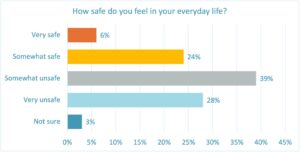
That only 6% overall feel “very safe” in their everyday life suggests a nation under acute stress due to the conflict.
One in four respondents (25%) have already personally witnessed violence. This violence and the expectation of violence help to explain why 18% have decided to flee their homes.
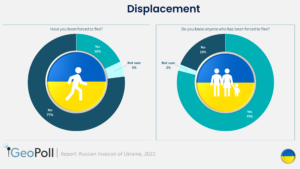
A significantly higher percentage (79%) say they know someone who has been forced to move or flee recently due to the conflict, painting a picture of what the UN high commissioner for refugees has called, “the fastest-growing refugee crisis in Europe since World War II.” This massive displacement is particularly dangerous for women and children who face a heightened risk of violence and exploitation.
The majority of respondents in our study (59%) say most of the people they know who have fled their homes have stayed within Ukraine (internally displaced). Most Ukrainian men ages 18-60 are currently banned from leaving the country, in anticipation that they may be called to fight.
Access to Essential Services
At the time of our study, 63% of respondents reported experiencing shortages of necessities, such as fuel, water, or electricity in the previous few weeks. That percentage is sure to increase as escalating Russian military strikes on large cities, including the capital city, Kyiv, inflict damage to essential infrastructure.
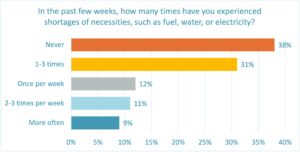
Food Security
The World Food Programme (WFP) reports severe shortages of food and water in embattled areas in Ukraine and in response has ramped up its food assistance operations. As the situation deteriorates, the agency is calling on the international community for a substantial increase in funding.
In our study, 84% of households say they ate less preferred and/or less expensive food at least 1 day in the past 7 days due to a lack of food or money to buy food. The largest segment (23%) say they ate less preferred food all 7 days.
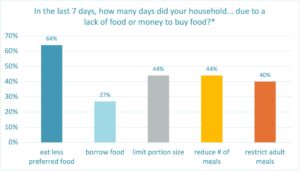
* The chart above shows the percentage of respondents that used each coping strategy at least 3 out of the past 7 days.
Almost half of respondents (46%) say they had to borrow food or rely on help from a friend or relative at least once in the past week, and more than half (60%) limited their portion sizes.
Another 61% reduced the number of meals eaten at least one day in the past week, with 18% reducing the number of meals eaten every single day. Most adults (56%) restricted their food consumption so children could eat – at least one of the 7 days last week.
News Platforms and Misinformation
In times of crisis, access to reliable news and information is critical. To help keep the public informed, both international war correspondents and Ukrainian journalists are putting their personal safety at risk to report on the situation on the ground. Several incidences of journalists being deliberately attacked by Russian forces in Ukraine have surfaced in the past few days.
Desperate for news, most of the respondents in our study are currently relying on multiple news platforms. Social media (Facebook, Twitter, WhatsApp, etc.), which offers real-time updates that users can follow from anywhere via their phones, is the most used platform at 69%. Many Ukrainian government officials and other authorities have turned to social media, primarily Telegram, as their preferred communication medium.
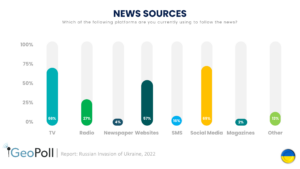
TV comes in a close second to social media at 66%, followed by news websites at 57%.
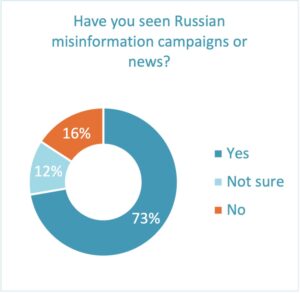 On the other side of the conflict, Russia has tightened its already strict restrictions on independent media, instead pushing out government produced misinformation and propaganda in an effort to distort reality and lower morale.
On the other side of the conflict, Russia has tightened its already strict restrictions on independent media, instead pushing out government produced misinformation and propaganda in an effort to distort reality and lower morale.
Most Ukrainians in our study (73%) recognize and have witnessed the Russian government’s misinformation campaigns and news.
Humanitarian Aid
With the Russian invasion posing an immediate threat to the lives and livelihoods of millions of Ukrainian civilians, humanitarian aid agencies are scaling up their response to the crisis.
Despite reports of Russian forces blocking the delivery of supplies into encircled and embattled cities, 68% of respondents claim that humanitarian aid organizations are currently in their area to provide relief. Most (59%) have noticed an increase in aid presence in the past few weeks.
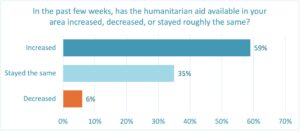
So far, only 13% of respondents say they or their immediate family have received international aid in the form of food, money, water, or other supplies. As the crisis deepens, however, more and more Ukrainians are likely to find themselves in dire need of humanitarian support.
Following is a list of humanitarian aid organizations that are soliciting donations to help Ukrainians.
- Doctors Without Borders
- International Committee of the Red Cross
- Project Hope
- UNICEF
- World Food Programme
- World Central Kitchen
Interactive Data Dashboard
Dive deeper into the full results from this study using the interactive dashboard below. The dashboard provides responses to each question in the survey, filterable by region, age group, and gender.
Conduct Research in Ukraine
GeoPoll has extensive experience conducting research in vulnerable areas through remote mobile-based methodologies. In times when it is otherwise impossible to get information from people on the ground, remote data collection can play a pivotal role in capturing the sentiment and realities in hard-to-reach locations.
To learn more about GeoPoll’s capabilities in Ukraine and around the world, please contact us.
